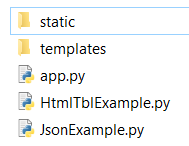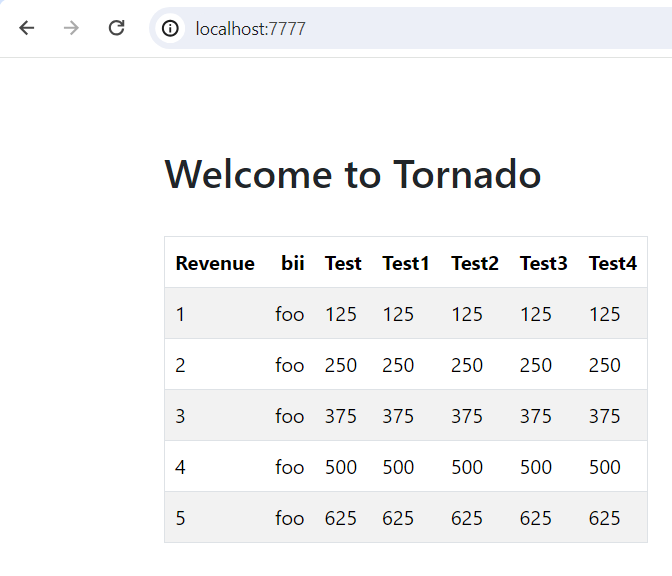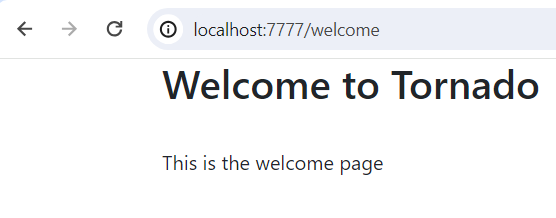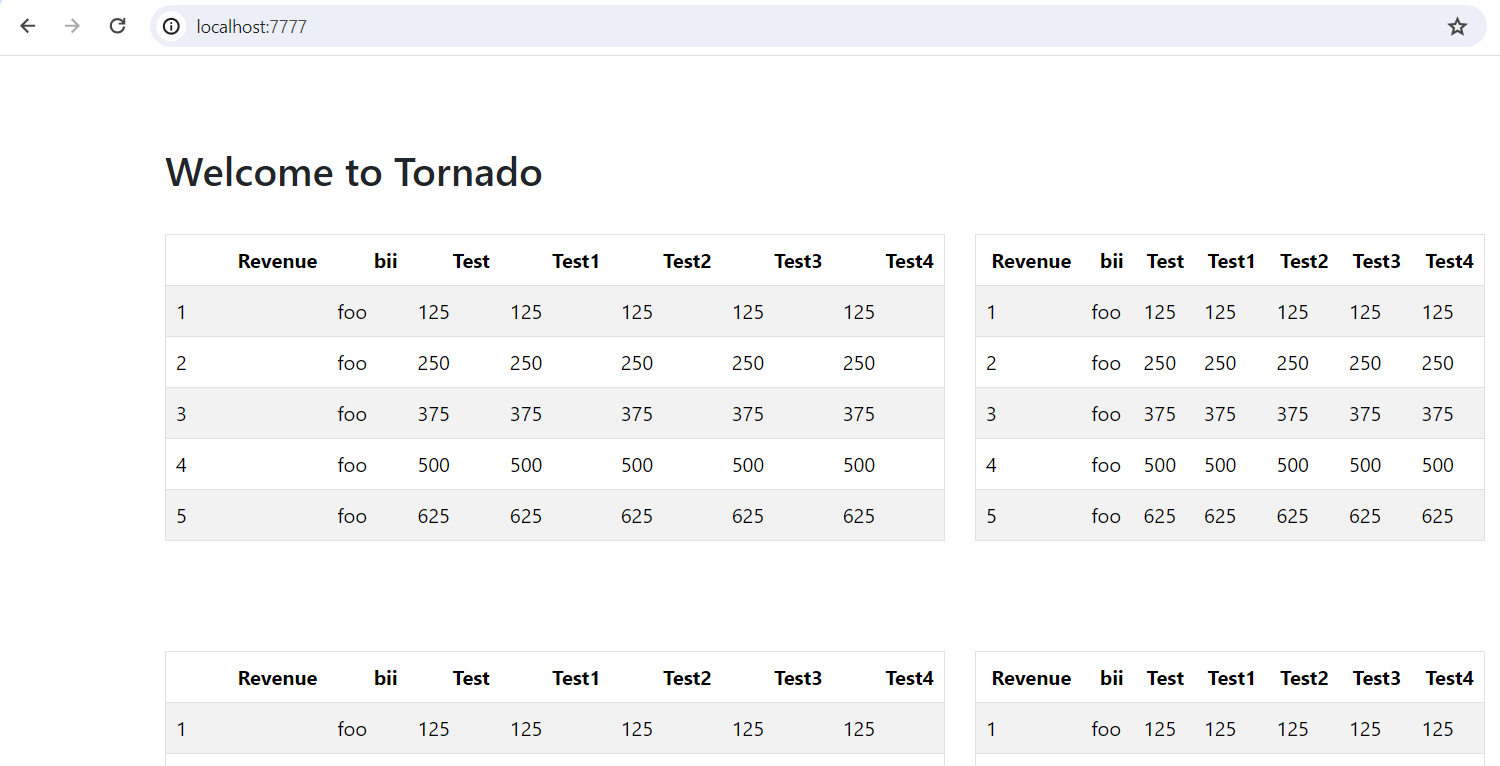This is the lesson that I am the most excited to show you. This is the lesson that opens up a lot of opportunities if you understand the concepts and the code.
I will show you how to route using Tornado.
- How to handle http://localhost:7777/about?
- What is the code to navigate to the about html page?
I will show you how to move data from the back-end to the front-end
- How to create a pandas DataFrame and show that data:
- As a json object (great for api scenarios)
- as a table (great for a basic html page)
The folder structure is very similar as all the previous lessons. I do have some additional python files in the root. These files could probably moved to a new folder under the static folder, but I kept them here for now.
Folder structure
 root folder
root folder
- static
- js
- bootstrap.bundle.min.js
- bootstrap.bundle.min.js.map
- css
- bootstrap.min.css
- bootstrap.min.css.map
- js
- templates
- index.html
- template.html
- SampleLayout1.html
- welcome.html
- app.py
- HtmlTblExample.py
- JsonExample.py
HtmlTblExample.py
Here I simply create some fake data and return an html object. We will use this function to show an html table to the user.
Note that I am passing bootstrap class names to the html table.
import pandas as pd
def html():
# Create a simple df
df = pd.DataFrame(data=[1,2,3,4,5], columns=['Revenue'])
# Add columns
df['bii'] = 'foo'
df['Test'] = df['Revenue']*125
df['Test1'] = df['Revenue']*125
df['Test2'] = df['Revenue']*125
df['Test3'] = df['Revenue']*125
df['Test4'] = df['Revenue']*125
return df.to_html(index=False, classes="table table-hover table-striped")JsonExample.py
Here I create some fake data and simply return a json object. JSON is a very common format you will encounter in the wild, so I added it here. We will display this json string on a web page very soon.
import pandas as pd
def to_json():
# Create a simple df
df = pd.DataFrame(data=[1,2,3,4,5], columns=['Revenue'])
# Add a column
df['bii'] = 'foo'
return df.to_json()App.py
Take a close look at all the new code as it has been placed here so you can see how to:
- Call functions
- Look how I imported the extra two python scripts and then used them throughout the code
- Display html content
- Look how the tbl variable is passed to Tornado. See how the index.html page looks for the tbl variable and displays it.
- Routing
- Look at the section that has r”/data2” and see how you can handle different kinds of http requests on your web application.
# Webserver stuff
import tornado.ioloop
import tornado.web
# User created scripts
from JsonExample import to_json
from HtmlTblExample import html
# Utility libraries
import os.path
class MainHandler(tornado.web.RequestHandler):
def get(self):
self.render('index.html',
page_title = 'This is Amazing!!!',
company_name = 'Business Intelligence',
tbl = html()
)
class welcome(tornado.web.RequestHandler):
def get(self):
self.render('welcome.html',
page_title = 'This is Amazing!!!',
company_name = 'Business Intelligence'
)
class data(tornado.web.RequestHandler):
def get(self):
self.write(to_json())
class data2(tornado.web.RequestHandler):
def get(self):
self.write(html())
settings = dict(
template_path=os.path.join(os.path.dirname(__file__), "templates"),
static_path=os.path.join(os.path.dirname(__file__), "static"),
debug=True
)
# r"/" == root website address
application = tornado.web.Application([
(r"/", MainHandler),
(r"/welcome", welcome),
(r"/data", data),
(r"/data2", data2)
],**settings)
# Start the server at port n
if __name__ == "__main__":
PortNumber = str(7777)
print(r'Server Running at http://localhost:' + PortNumber + r'/')
print(r'To close press ctrl + c')
application.listen(PortNumber)
tornado.ioloop.IOLoop.instance().start()template.html
Nothing new or exciting on the template file.
<!DOCTYPE html>
<head>
<title>{{ escape(page_title) }}</title>
<link href="{{ static_url('css/bootstrap.min.css') }}" rel="stylesheet">
<script src="{{ static_url('js/bootstrap.bundle.min.js') }}"></script>
</head>
<body>
<div class="container">
{% block content %}
{% end block %}
</div>
</body>
</html>index.html
Notice how I had to add the raw keyword to display the html table correctly. Also note that you will be experimenting with a lot of bootstrap and html code. This is probably my least favorite thing about front-end coding. You have to try many many variations to get the final result you are looking for.
{% extends "template.html" %}
{% block content %}
<div class="container">
<br/>
<br/>
<br/>
<h2>Welcome to Tornado</h2>
<br/>
<div class="row">
<div class="col-2">
{% raw tbl %}
</div>
</div>
</div>
{% end block %}
// {% autoescape None %} if you put this at the top, it will affect everything
// {% raw *expression* %} does not escape the expressionwelcome.html
Very basic web page.
{% extends "template.html" %}
{% block content %}
<div class="container">
<h2>Welcome to Tornado</h2>
<br>
<p>This is the welcome page</p>
</div>
{% end block %}SampleLayout1.html
Here is a challenge for you. See if you can get this html page to render. You have to make some changes to the app.py file.
{% extends "template.html" %}
{% block content %}
<div class="container">
<br/>
<br/>
<br/>
<h2>Welcome to Tornado</h2>
<br/>
<!--Place two tables side by side-->
<div class="row">
<div class="col-6">{% raw tbl %}</div>
<div class="col-4">{% raw tbl %}</div>
</div>
<!--Add a little space between the tables-->
<br/>
<br/>
<br/>
<!--Place two tables side by side-->
<div class="row">
<div class="col-6">{% raw tbl %}</div>
<div class="col-4">{% raw tbl %}</div>
</div>
</div>
{% end block %}
// {% autoescape None %} if you put this at the top, it will affect everything
// {% raw *expression* %} does not escape the expressionRun the application





Here is how the SampleLayout1.html looks like. Yes, the picture is cutoff at the bottom. Hopefully you were able to get this page to render. It is a very small code change.
